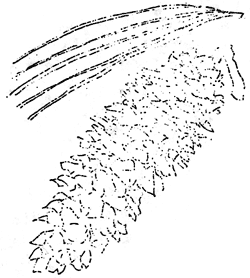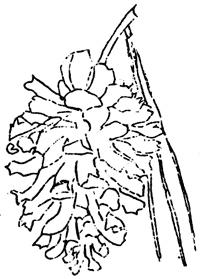How to Know the Pines
We are fortunate at Crater Lake National Park in having a very representative collection of coniferous (cone-bearing) trees: pines, hemlocks, spruces, and firs. Most of the park area, except for the pumice flats, and exposed rock masses, is covered by these evergreens, which clothe the barren slopes of ash and lava with a perpetual mantle of pleasing verdure. Even such cinder cones as Wizard Island and Timber Crater are ornamented with forests.
The pines are not only easy to tell from all other trees, — they are our only conifers which bear their needles in cluster — but are readily distinguishable one from another. In addition, they are fairly well segregated as to altitude, and serve as “Zone Indicators”. We find that plant and animal life varies with the altitude, and that in ascending a mountain we pass through definite layers of living things, termed “Life Zones”. Some plants and animals are limited to a definite band, and occur almost universally throughout it. By learning to know a few such forms, we can easily tell which zone we are in, and know what sort of life we may expect to see there.
The zones of altitude correspond with geographical zones, or zones of latitude, and are named for the latter, so we have the Arctic-Alpine, the Hudsonian, the Canadian, the Transition, the Sonoran Life Zone, et cetera. The further south we go, the higher we must climb to reach a given layer. At our latitude, the Hudsonian Zone is found from about six thousand feet to higher levels of the Park (less than nine thousand feet); the Canadian, from six thousand to five thousand; and the remaining area, five to four thousand feet, lies in the Dry or Arid Transition Zone. We find that the five varieties of pine native to the Park are well-distributed through these three zones.
Our pines may conveniently be divided into two groups — the white pines, and the yellow pines. The first class is characterized by bearing its needles in groups of five, and possessing a gray or whitish bark, which is either smooth or furrowed. The White-Bark Pine (Pinus albicaulis Engelm.) is the only pine found in our Hudsonian Zone. It is the common tree about the South Rim, on Cloud Cap, Garfield Peak, Scott Peak, Llao Rock and elsewhere. Growing at such a high elevation, and exposed to severe weather conditions, it is usually twisted and bent, so that its wood is of no commercial value. The cones of this tree are three inches or less in length, and oval to ovoid in shape.
In the adjacent zone, the Canadian, we find the Western White Pine (Pinus monticola Don.). This tree is common on Wizard Island, and upon the Inner Rim of the Lake. It is usually tall and straight, reaching a considerable height. The needles occur in fives, but are somewhat longer than those of the preceding tree, and do not clothe the branches so densely. The cones are six to eight inches long, and narrowly cylindrical. The White Pine produces a fine-grained white wood, which is chiefly valuable as a substitute for the Sugar Pine.
The king of the White Pines — the Sugar Pine(Pinus lambertiana Dougl.) — is an immense tree, which unfortunately, occurs but rarely in the park, and then only in the lower reaches of the Transition Zone. The needles — again in fives — are rather long, and the huge cones, thirteen to eighteen inches long, immediately distinguish it from all its lesser relatives. While very scarce in Oregon, the Sugar Pine is one of the most valuable timber trees of California, where ninety-eight per cent of that variety is manufactured. The wood is white, soft and straight-grained, and is often used for interior finish.
While passing through the lower areas of the Park, you may see a pine whose trunk resembles a stately bronze column. The coppery bark is usually broken up into rectangular patches, which scale off easily. This is the Western Yellow Pine (Pinus ponderosa Dougl.), the only tree in the park which bears its needles in groups of three. Like the Sugar Pine, it occurs only in the Transition Zone, and serves as an indicator throughout the Cascades and Sierra Nevada. The cones are three to five inches long, oval to globular, and beset with prickly points. Although it produces a soft, somewhat resinous wood, it is very highly regarded as a source of cheap lumber.
The Lodge-pole Pine (Pinus contorta Dougl. var.marrayana Englem.) is a slender tree, growing in dense stands throughout the Canadian Zone, as about Park Headquarters. It has a thin, dark-colored, smoothish bark, which is easily penetrable, and as a result the Mountain Pine Beetle (Dendroctonus monticola Hopk.) makes it chief ravages against this species. The “Ghost” of “Silver Forests” towards Diamond Lake are largely stands of the Lodge-pole Pine, which have fallen a prey to this vicious pest. The cones are small, oval and prickly, and the needles are borne if fascicles of two. The low, twisted Beach Pine (Pinus contorta Dougl.), found only at sea level, is frequently considered to be a low altitude form of the Lodge-pole, but the great variance in general aspect make it seem quite likely that the two should be regarded as distinct species. For some reason, the Lodge-pole Pine locally passes under the name of “Tamarack”, but this is entirely erroneous, for it has no close relationship with the true, Swamp-growing, deciduous Tamarack (Larix species) of the Eastern United States.
“By the needles ye shall know them!” might be our watchword in telling the pines apart. The number of leaves in a cluster, the size and shape of the cones, the color of the bark, and the altitude at which the trees grow give us a series of clues to their identity. After you have examined the cones and needles of each a few times, the general shape, size, and aspect of the trees will enable you to recognize the five types, as you merely drive through the forests.



